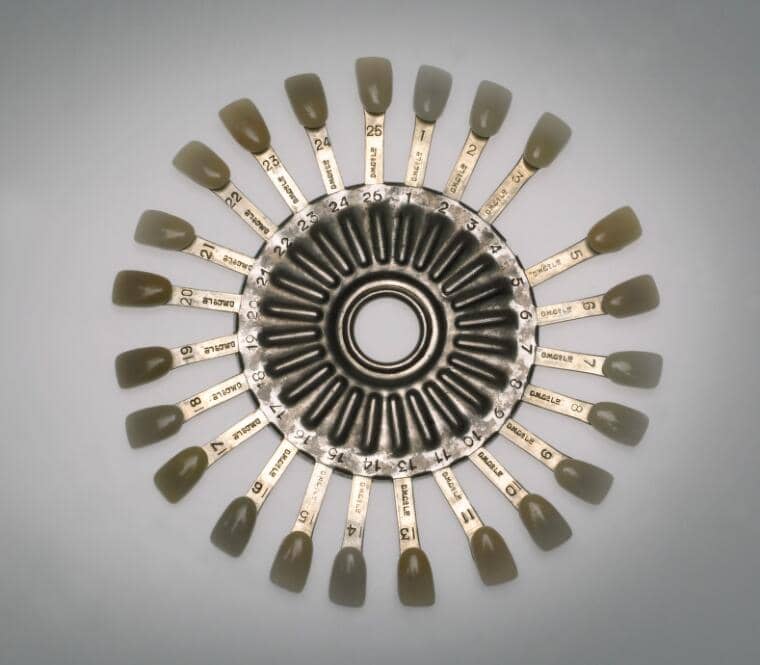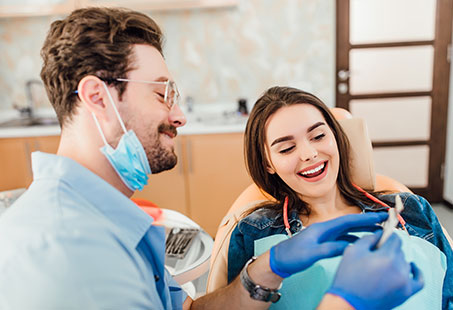Teeth come in a variety of hues, colours, and brightness levels. There can be small variations even within the same set of teeth. So, choosing a dental restoration’s colour is not easy, which is why a teeth shade guide is used. This helps patients achieve their aesthetic goals.
Keep in mind that while the expertise of the dentist matters here, you should also know how shade guides work so that you can choose the best colour for yourself. This way, you can get the most aesthetically pleasing results.
What Is A Teeth Shade Guide?
A teeth shade guide is used as a reference point for matching the colour of the artificial teeth with the natural teeth. Since dental restorations (crowns and veneers) are made of different materials, such as porcelain, ceramic, resin, acrylic, and zirconia, among others, different types of shade guides are available based on the material.
Keep in mind that there is no standard colour guide. Usually, dentists use VITA shade guides, but there are many others that are commercially available. Some even make custom shade guides for their patients. And even though there’s a limited number of shades on a particular spectrum, other variations are possible by mixing up the colours.

However, keep in mind that it’s not simply about choosing a shade from the tooth guide. Your dentist has to take other things into account, such as the:
- Underlying colour of the tooth
- Thickness of the restorative material
- Skin tone
- Size of the lips (how much shadow they cast)
- Colour of the lips
- Colour of the eyes
Additionally, there are three parts of the tooth: the neck (cervical), middle body and incisional area (the biting end). And the colour can vary along these three regions. This is why your dentist has to be very careful when matching the shade of the tooth. It’s always a good idea to check out the before and after pictures of patients who have the same shade.
What Is Shade Matching?
To understand shade matching, you need to know about: value, hue (colour) and chroma. It’s the separation of these three components that have allowed shade guides to become more accurate.
- Value: Refers to how light or dark the tooth is.
- Chroma: Refers to how much of the same colour is in the tooth.
- Hue: Refers to the actual colour of the tooth. It could be yellow, brown, grey, red or a combination.
Keep in mind that different shade guides can have a different range of values, chromas, and hues. In some types of tooth guides, the hues or colours are represented by alphabets. For instance, the classic VITA has 4 groups of colours:
- A – Reddish Brown
- B – Reddish Yellow
- C – Grey
- D – Reddish Grey
Within each colour group, there can be variations based on chroma. And as the number increases, the value increases (meaning the tooth gets darker). However, there are more complex shade guides than that, like the one above.
VITA 3D’s values are represented by numbers and the chromas of each colour group arranged in a column from top to bottom (1-3). In addition, each group has further 3 categories: L, M, and R. L is for yellow, M is for yellow-red and R is for red colour. In total, it has 26 tooth shades. Keep in mind your dentist can ask the lab to mix the colour to get a better shade.

How To Choose The Right Shade For Teeth?
The tooth guides come with instructions on how to properly match the colour of the artificial teeth or prosthetics with the natural teeth.
First, the dentist will decide on the value (the lightness level). Following that, the chroma of the tooth is chosen, and lastly the hue. For instance, if the dentist’s using a VITA 3D-Master:
- First, the value will be chosen, somewhere between 1 and 5 (going from dark to light). Say the best match is value 2.
- There are three colours in value 2: yellow (L), yellow-red (M) and red (R). First, the yellow-red coloured teeth are taken and held next to the natural teeth.
- If they don’t have a good match, yellow and red coloured teeth are checked for a more accurate shade.
Mostly, this process is done by holding the tooth close to your actual tooth. However, some dentists also use an electrical device to get the value of the tooth shade.
Keep in mind that your dentist will show the chosen shade to you. Make sure you understand why they chose that particular shade. And if you have any qualms about it, let your dentist know.
What To Consider When Choosing The Colour Of Teeth?
Your dentist should match the tooth shade in ample light at eye level. That’s because the changes in light affect the perception of the colour. Natural light can help you and your dentist choose the best shade.
Additionally, the “eyes get tired” after 5-7 seconds, so dentists are recommended to go with the first option. So, you should also not look at the shade for too long, as it may only make you less sure of it.
Also, avoid wearing lipstick or wearing clothes of striking colours because they can alter the perception of your tooth’s shade. And lastly, make sure to clean your teeth before going to the dentist.
Conclusion
Primarily, it’s the dentist’s responsibility to help you choose the right tooth shade. But it is also your responsibility to clearly communicate your expectations. Also, once the dentist shows you the right shade for your teeth, you should see it yourself to get an idea of the results.
While before and after pictures of patients can help, remember that differences in the shape and colour of lips and skin tone can make the same shade look different. So, do your research and find a dentist that’s experienced and board-certified.
